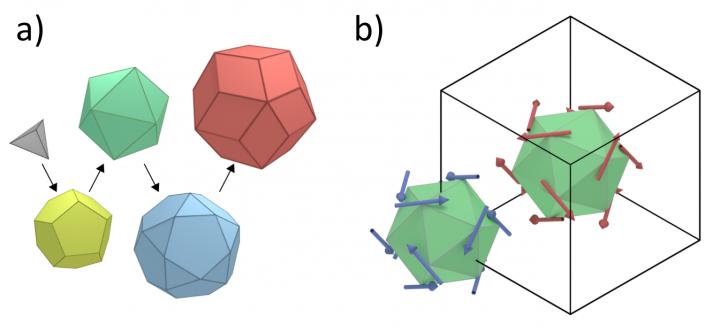Scientists reveal peculiar surface structure in materials resembling quasicrystals with interesting implications for its magnetic properties

Credit: Ryuji Tamura of Tokyo University of Science
Between chemistry classes, gemstones, and electronics, the idea of crystals, substances with an ordered and periodic arrangement of atoms is quite common. But about 40 years ago, a strange particle was discovered by scientists that hasn’t become commonplace in our world yet: quasicrystals. These are structures with curious atomic arrangements, which, while superficially similar to crystals, lack periodicity despite being ordered. Because of their structures, quasicrystals exhibit symmetries forbidden to crystals and are endowed with interesting properties that crystals cannot show, such as high resistance to heat flow, current flow, and corrosion.
Since their discovery, quasicrystals have been researched extensively by materials scientists around the world. Due to their rarity, scientists have often resorted to studying models mimicking them, called approximants. Recently, in a class of gold-based approximants, called “Tsai-type approximants”, the presence of magnetic order was detected whose type can be controlled by the composition of the approximants–an exciting possibility for material scientists to explore.
In such approximants of increasing complexity, such as that composed of gold (Au), aluminum (Al), and terbium (Tb), the magnetic order was found to be antiferromagnetic, where each ion in the crystal acts as a small magnets with its poles opposite to those of its neighbors. In a new study published in Physical Review B, Prof. Ryuji Tamura from the Tokyo University of Science (TUS), Japan, along with his colleagues Sam Coates of TUS, and Hem Raj Sharma and Ronan McGrath of the University of Liverpool, explored the atomic structure of the antiferromagnetic surface this Tsai-type approximant. Prof. Tamura, who led the study, says: “Au-based Tsai approximants are under-researched compared to their silver (Ag)-based counterparts, particularly in the field of surface science. Understanding the structures of these Tsai-type materials will allow for in-depth interpretations of their specific properties, such as magnetic transitions, electronic features, and superconductivity.” Their study yielded unexpected results.
The building blocks of Tsai-type approximants are “Tsai-type clusters”, polyhedral shells whose number of sides depends on the variant of the approximant. In their study, Prof. Tamura’s team chose a 1/1 variant of the Au-Al-Tb approximant in which a tetrahedral unit was enclosed within a dodecahedron, icosahedron, icosidodecahedron, and rhombic triacontahedron. The Tb atoms occupied the vertices of the icosahedron while the Au/Al atoms occupied the vertices of the remaining shells.
The scientists looked into a specific surface of a single crystal of the 1/1 Au-Al-Tb using a scanning tunneling microscope (STM) and backed up their observations with density functional theory (DFT) calculations.
They found that the surface had a peculiar step-terrace-like structure with the terraces ending at planes containing Tb atoms and a step height that, interestingly, appeared to minimize the number of incomplete icosahedrons. Furthermore, they found that the terrace structure depended on the sign of the biasing voltage applied to the sample. While at positive bias, the Tb atoms showed a rhombohedral or hexagonal arrangement, negative bias revealed the Au/Al atoms to be arranged in a linear row-like structure, a kind of switching not observed in a Tsai-type material before. “As this is the first Tsai-type material to show such a scheme, we need to further investigate Au-based Tsai types to assess whether chemical composition has a role to play in surface structure,” comments Prof. Tamura. The observations were consistent with DFT calculations.
While quasicrystals have found several applications, ranging from surgical instruments, LEDs to non-stick frying pans, they are far from being well understood and the recent findings in quasicrystal-like structures serve to hint at the untapped exotic possibilities they harbor. “The unique structure of the Tsai-type surface suggests that quasicrystals could be used as a template for molecular adsorption in the creation of organic semiconducting thin films,” Prof. Tamura says. “Understanding of how the structure change corresponds to the magnetism can open doors to new applications,” he adds.
One thing’s for sure: the quasicrystal is a little clearer!
###
About the Tokyo University of Science
Tokyo University of Science (TUS) is a well-known and respected university, and the largest science-specialized private research university in Japan, with four campuses in central Tokyo and its suburbs and in Hokkaido. Established in 1881, the university has continually contributed to Japan’s development in science through inculcating the love for science in researchers, technicians, and educators.
With a mission of “Creating science and technology for the harmonious development of nature, human beings, and society”, TUS has undertaken a wide range of research from basic to applied science. TUS has embraced a multidisciplinary approach to research and undertaken intensive study in some of today’s most vital fields. TUS is a meritocracy where the best in science is recognized and nurtured. It is the only private university in Japan that has produced a Nobel Prize winner and the only private university in Asia to produce Nobel Prize winners within the natural sciences field.
Website: https:/
About Professor Ryuji Tamura from Tokyo University of Science
Dr. Ryuji Tamura is a Professor in the Department of Materials Science and Technology at Tokyo University of Science, Japan. His research interests include the study of quasicrystals, approximant crystals, metallic glasses, and nanocomposite magnets. A senior and reputed researcher, he has more than 140 publications and 3 patents to his credit. He was awarded the Japan Institute of Metals Murakami Young Researcher Award and the Japan Institute of Metals and Materials Meritorious Award in 2010 and 2014, respectively. His research can be found at: https:/
Funding information
This study was supported by Kakenhi Grants-in-Aid (Grants No. 19H05817 and No. 19H05818) from the Japan Society for the Promotion of Science.
Media Contact
Tsutomu Shimizu
[email protected]
Original Source
https:/
Related Journal Article
http://dx.




